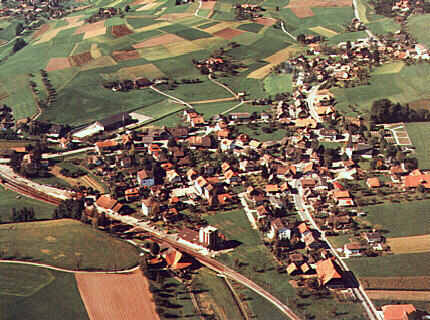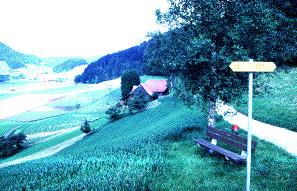 At
right: an overhead view of the village of Zaziwil.
At
right: an overhead view of the village of Zaziwil.The "Roots" Village of Zaziwil
 At
right: an overhead view of the village of Zaziwil.
At
right: an overhead view of the village of Zaziwil.
In The History of the Kraybill Family in America, Spencer Kraybill quotes from Brief aus Zentralstelle der Schweizerischen Gesellschaft fuer Familienforschung, Bern Dec. 12, 1944, as follows:
"In Canton Berne, the family Kraehenbuehl lived in that part which is bound by the cities of Berne, Thun and Langnau. Most likely these Kraehenbuehl families were occupied entirely by agriculture.
"The little village of Kraehenbuehl is near Grosshoechstetten and Signau in the Emmenthal Valley and has about 40 inhabitants. The village has been inhabited by German-speaking peasants and has belonged to Canton Berne for about 550 years." (Ueli Barger, a genealogist who grew up near Zäziwil, wrote to say that the area apparently referred to here is known as Chrajbuel and is, in fact, a farm, with just two buildings.)
 This is a view of the Emmenthal
Valley, with the sign in the foreground bearing the name Chrajbuel, indicating the area in
question just outside Zäziwil, Switzerland.
This is a view of the Emmenthal
Valley, with the sign in the foreground bearing the name Chrajbuel, indicating the area in
question just outside Zäziwil, Switzerland.
J.D. Stahl of Blacksburg, Va., whose mother was a Kraybill, took the photo while on a trip to the area a few years ago.
J.D. wrote the following account of his visit for the The World Wide Kraehenbuehl Family Site:
"Zäziwil is an idyllic village in the Emmenthal region near Bern, Switzerland. It is located approximately halfway between Grosshöchstetten and Signau. The region is one of rolling hills and fertile valleys.
"On the hillside above the town of Zäziwil lies the Chrajbuel Hof, which once
belonged to the Krähenbühl family.
 It
has the date 1782 carved into a doorpost in the shed adjacent to the house (which is
pictured at right [picture missing]). Many Krähenbühls still live in Zäziwil, and many
lie buried in the Zäziwil churchyard.
It
has the date 1782 carved into a doorpost in the shed adjacent to the house (which is
pictured at right [picture missing]). Many Krähenbühls still live in Zäziwil, and many
lie buried in the Zäziwil churchyard.
"Zäziwil lies 680 meters above sea level and is one of 28 communities of the regional administration of Konolfingen in the Canton of Bern. In 1850 the town had 1042 inhabitants, in contrast to 1290 in 1986, Since 1864, the railroad (SBB) connects the town with Bern and Langnau. Zäziwil is the point of origin for many worthwhile hikes (Blasenfluh, Moosegg, Aebersold, Appenberg).
"According to a chronicle by Jahn, the village of Cezzenwile (early spelling of Zäziwil) is first mentioned in documents in 1299. The church community of Hochstetten, including Zäziwil, belonged to the 'Dekanat' of Munsingen, which was owned by the counts of Kyburg. In 1632 the area passed into the hands of the lords of Buren and then, by means of mortgage, to the city of Bern. The nobles of Bannmoos later purchased it and sold it in 1494 to the Stift in Bern.
"In the 18th century, Zäziwil supported a curative spring in the Leimen part of town. In 1725 the members of the Bern government attested to the healing powers of the Höhli-bath. At that time, both internal and external diseases were supposed to have been bathed away there. Today the same spring still supplies drinking water to a number of households.
"Since 1964, the community has a modern church building that fits well into the general townscape. In 1978 the community erected a recreation hall or gymnasium with a "Schwingkeller" (wrestling cellar). The Civil Defense facilities were completed in 1987.
"In the dining room of the hotel/restaurant Zum Weißen Rößli in Zäziwil, you will find a reproduction of the Krähenbuhl coat of arms hanging on the wall, along with the coats of arms of many other local families."
More About Zäziwil and the Krähenbuhl Coat of Arms
(Has anyone else visited this village? Can you provide other interesting details of its past or present? Please e-mail your contribution to Margaret Crabill Mead and it will be added here.)
Home Page of the Krahenbuhl Family | European Connections